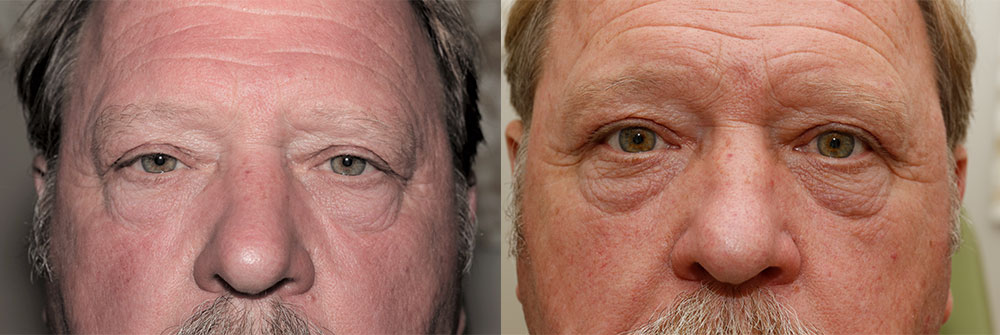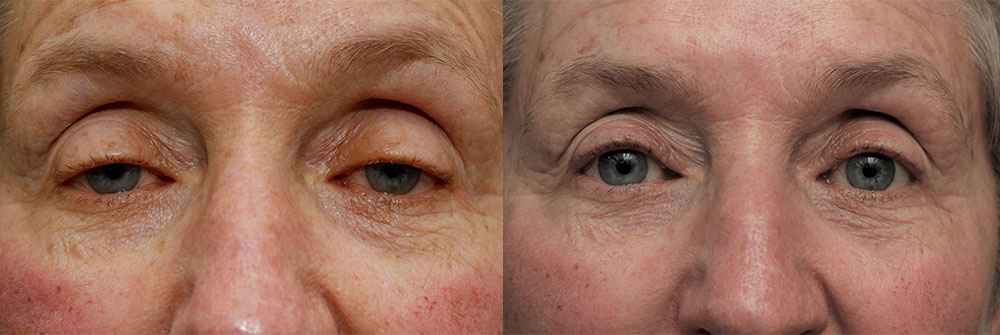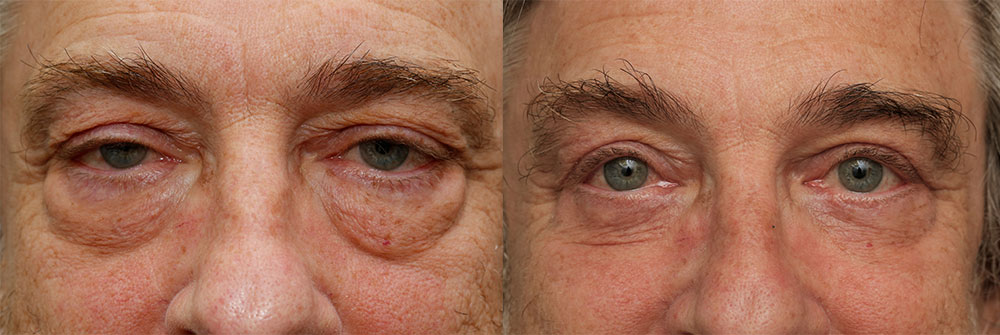
Ptosis, a condition resulting in droopy eyelids or droopy brows, can cause vision impairment and make daily living challenging. Clear vision and healthy eyes require well-functioning eyelids; however, over time we can develop ptosis that restricts our field of vision and requires surgical intervention. Board-certified oculofacial plastic surgeon Dr. Vivian Schiedler of Oasis Eye Face and Skin located in Ashland, OR, can help to improve ptosis symptoms.
What is Ptosis?
There are two main types of ptosis: eyelid ptosis and brow ptosis. Ptosis is generally seen in older adults, but in rare cases, it can happen in children or newborns. If left untreated in children, it can prevent normal vision development and lead to the onset of a lazy eye. Ptosis should not be confused with dermatochalasis. Although they are similar, dermatochalasis is caused by excess and loose skin found on the upper eyelid.
Eyelid Ptosis
Eyelid ptosis refers to the eyelid drooping down and blocking the eye, without the brow being affected. It can affect one or both eyes and can be present at birth or develop later in life. Droopy lids can give a person a sleepy, tired, or disinterested look.
Brow Ptosis
As people age, the eyebrow tissue slowly droops down onto the eyes. If the brow falls well below the brow bone, it can cause visual impairment. Droopy brows can give a person a tired, sad, or angry look.
Causes of Ptosis
The most common cause of a droopy eyelid is levator muscle detachment, the muscle responsible for raising the eyelid. This can happen due to aging and loss of connective tissue, or from chronic rubbing. Other causes include congenital diseases, long term hard contact lens use, or weakness of the levator muscle. Less commonly, a nerve problem, tumor, injury, degenerative muscle disorders, or autoimmune condition might be the culprit of the ptosis.
Oculofacial plastic specialists such as Dr. Schiedler are highly trained in diagnosing and coming up with a treatment plan for ptosis. They can also determine if there are any underlying conditions causing the ptosis and attack the root of the problem instead of just the symptoms.
People at risk for developing ptosis include older adults and those with a family history of ptosis. Diabetes, neurological disorder, wearing hard contact lens, sleep apnea, and chronic eye rubbing also increase the risk of developing eyelid or eyebrow ptosis.
Treatment Options for Ptosis
Most droopy eyelids and eyebrows require surgery to tighten the eyelid muscle and lift falling brow tissue. Depending on the severity of the droopiness, this procedure may be covered by insurance. Most of the time, the ptosis has to be severe and affect vision in order to warrant a necessary medical procedure. Milder forms of ptosis may fall under cosmetic surgery and payment may be the responsibility of the patient. An office test called a visual field is used to demonstrate the visual blockage. Photographs are taken to document how far the droopy eyelid or brow is covering the eye, and these are submitted to insurance companies.
There are a few instances, like those suffering from myasthenia gravis, that may improve with oral medications.
How is Eyebrow Ptosis Repair Performed?
There are several ways to lift droopy eyebrows. Some smaller brow lifts or forehead lifts can be performed under local anesthesia in-office, while larger brow lifts or forehead lifts require intravenous sedation at an ambulatory surgery center. A brow lift raises the brows in one of three ways.
Direct or midforehead brow lift
Tissue is removed by making an incision just above the eyebrow if the brow hair is thick, or by camouflaging the scar within the forehead wrinkles.
Endoscopic brow lift
Incisions are made in the scalp behind the hairline, and the entire forehead tissue is released off the bone with long flat instruments. Botox or Xeomin are often used to weaken the eyebrow muscles pre-surgery and keep them weak throughout the healing process. The forehead tissue is then anchored higher up on the bone with the use of tiny screws or dissolving hooks.
Transfollicular subcutaneous brow lift or hairline brow lift
An irregular, angled incision is made just behind the hairline. Skin is then released off the frontalis muscle, or forehead lifting muscle, and excess skin is overlapped and removed. The preserved hair follicles grow back through the incision, camouflaging the incision nicely.
How is Eyelid Ptosis Repair Performed?
Ptosis repair surgery is performed under local anesthesia or intravenous sedation. Once anesthesia is administered, the levator muscle is reattached from either the front (external side) or back (internal side) of the eyelid.
If the external side is used, some skin may be removed to lighten the eyelid and improve appearance. The patient may be woken up momentarily to check the contour, height, and symmetry of the eyelids, and then sedated again. If both upper eyelids are droopy, it is best to repair them at the same time to ensure symmetry.
When repairing the muscle detachment from the internal side, the patient can be kept asleep for the entire surgery. Measurements are taken before surgery to determine the correct amount of tightening and predetermined measured amount of tissue is removed using a special instrument. This internal approach can sometimes avoid a skin incision altogether and tends to heal rather quickly.
What to Expect Following Ptosis Repair
To keep bruising and swelling at a minimum, patients should stay home for two to three days after surgery and avoid strenuous activity for a week. It is also recommended to frequently apply soft, lightweight, cold compresses to the treatment area. Sleeping with your head elevated using pillows or a recliner also helps keep the swelling down. Healing times vary depending on the age of the patient, other health conditions, and the extent of the ptosis repair.
For eyelid ptosis, the skin incision typically heals as a very fine line. Dr. Schiedler is exceptionally meticulous and skilled at using fine hair-like sutures to help create a natural-looking result. In children and some adults, she may opt for tiny clear dissolving sutures when performing ptosis repair to correct droopy eyelids. Swelling may cause blurry vision or incomplete blinking temporarily. This is entirely normal and typically resolves as the swelling goes away.
Brow lift incisions may be pink for weeks or months, depending on skin type. Numbness or sensitivity in the incision sites may last weeks or months, but typically all numbness is gone by six months.
Strenuous physical activity should be avoided immediately after surgery and during recovery. You should also protect your incisions from UV or sun exposure to prevent darkening of the skin.
Vision improvement will be immediate, but final results may take as little as a few weeks. However, depending on healing rates and other factors, some patients don’t report seeing the final results until months later.
Lift Droopy Eyelids and Brows with Ptosis Repair at Oasis Eye Face and Skin
The eye area is extremely delicate and should always be entrusted in the hands of a specialized oculofacial plastic surgeon. Dr. Vivian Schiedler uses her training as an ophthalmologist and oculofacial plastic surgeon to successfully diagnose and treat ptosis while ruling out serious causes. Her experience helps her achieve the best possible aesthetic and functional results. If you believe you are suffering from ptosis that is making you self-conscious or interfering with your vision, contact Oasis Eye Face and Skin at (541) 708-6393 to schedule a consultation.






